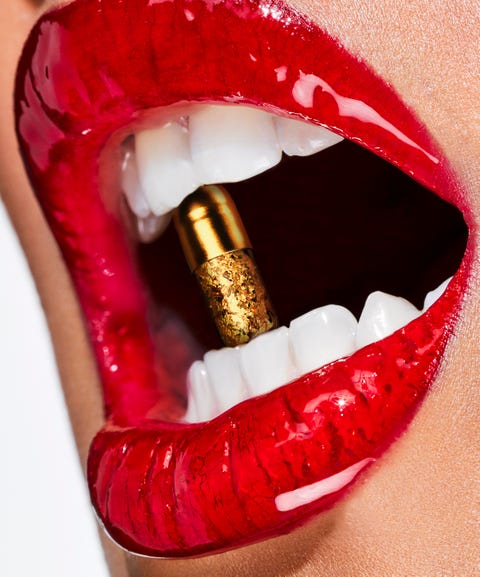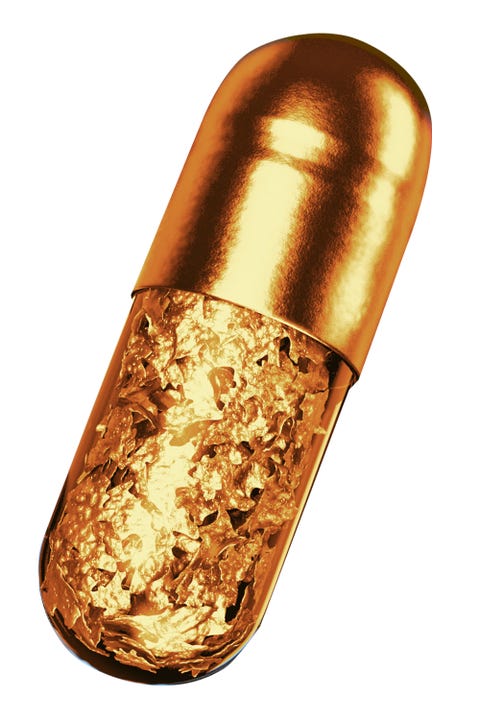Harper's Bazaar, November 2017, 150th Anniversary Issue, P. 316 :
The Future of Anti-Aging
Experts believe that exciting new innovations in the longevity space may one day redefine the way we age—and help us look better as we do it.
“Technology has reached a point where extending
animal life span by 30 percent is routine,” says David Sinclair, a
professor of genetics at Harvard Medical School and a renowned authority
on longevity. “Dozens of companies are testing aging-reversal
technologies in human clinical trials, and the combination of these
could extend life span by decades.” Why is that a good thing? Because
with science, those additional years could be happier, healthier ones.
It does seem cruel, however, to have all that extra time if we’ll also
look 150 years old. Fortunately, the most visionary anti-aging
treatments on the horizon make pioneering plastic-surgery procedures
seem run-of-the-mill. Read on to find out how a key supplement, DNA
editing, and young blood could someday add years to your life, erase
wrinkles, and potentially wipe out age-related diseases.
A
molecule called NAD+ may hold the secret to boundless energy. The good
news: Our cells already produce it, as it helps regulate our metabolism.
The bad news: NAD+ declines as we age—by 50, levels are half of what
they were at age 20. But scientists have discovered some powerful
boosters that can help cells produce more NAD+. One of the most
promising is NMN (nicotinamide mononucleotide), a form of vitamin B3
found in fruits and vegetables like avocado and broccoli. A 2013 study
showed that older mice that were given an NAD+-boosting compound
containing NMN had dramatically healthier cells and muscle tissue. “We
took a mouse that was the human equivalent of a 65-year-old back to a
25-year-old—in a week,” says Sinclair, one of the study’s authors.
What’s more, he says, the mice not only had more energy and could run
farther but were resistant to diseases like cancer and diabetes. “If you
reverse aging in one organ or tissue, usually the whole body is
reversed, because all cells have the same underlying defects,” he
explains.
Could NMN have the same effect on us? Sinclair, 48,
has been taking his own custom NMN supplement (500 milligrams) for
almost two years. Tests have revealed that his cells now behave like
that of a 31-year-old. “I started taking it in my late 40s, and
sometimes in your late 40s you feel tired during the day or you don’t
feel like getting up early in the morning,” he says. “I don’t feel that
way anymore. I feel upbeat mentally and physically, and I have the
endurance of an athlete, but I don’t exercise.”
Another NAD+ booster, NR (nicotinamide riboside), found in ChromaDex’s Tru Niagen supplement
(different in molecular structure from NMN, which Sinclair says is
“better” and more stable than NR), can easily be purchased online, and
has been shown to be safe in humans. “A single dose of 100 milligrams
can raise NAD+ levels,” says Amy Boileau, director of scientific affairs
for ChromaDex. Boileau believes that restoring depleted NAD+ levels
could lead to fewer wrinkles but that additional testing is required.
“It’s not hard to find a disease associated with NAD+ depletion that
doesn’t also affect [visible aging],” she says. “I would like to see it
work in skin because there’s so much promise there. It’s going to be an
important question as to the role NAD+ can play.”
In August, Sinclair and his team began human trials
on a prescription-strength NMN NAD+ booster. “We’re trying to see if
it’s safe, and what the best dosage would be before going into Phase II
studies with a particular disease, like diabetes or obesity,” he
explains. The idea that a simple molecule could restore lost energy and
wipe out major diseases seems like a fantasy. But Sinclair is resolute.
“Antibiotics are pretty simple too,” he says with a shrug. “We first
showed that NAD+ extends the life span of cells back in 2003, but now
it’s really taken off. It’s real.”
Look Younger by Editing Your Genes
You
may one day be able to delete the negative signs of aging from your DNA
for good. In late summer, the news was ablaze with talk of a
fascinating procedure. Scientists at Oregon Health & Science
University successfully removed harmful gene mutations from human
embryos. Specifically, they fixed a mutation behind a common heart
condition. Using a gene-editing tool known as CRISPR, or “genetic
scissors,” they cut out the mutation and inserted a reparative enzyme.
“If you want to add functionality to a gene, knock it out altogether, or
change it just a little bit— that’s what CRISPR gave us the ability to
do,” says biologist Daisy Robinton, a postdoctoral scientist at Boston
Children’s Hospital who has used it in her work on cancer cells to
positive result.
Though there were related
stories warning of more nefarious uses for gene editing—designer babies,
for example—for now, the focus is on higher-stakes concerns. Many
CRISPR human trials are currently being done in China on patients with
HPV, HIV, and lung cancer. “At first it’s going to be used only on cases
where it’s worth the risk,” Robinton says, “and on people who are
willing to take the risk because they don’t have many options.” As to
whether CRISPR will be used for vainer pursuits—think curing baldness,
eliminating gray hair, erasing wrinkles—Robinton, 30, is optimistic.
“This isn’t the first time that biotech has invaded the beauty space,”
she says. “It’s not [yet] real, but it’s our hopeful reality.”
Other forms of genetic rejuvenation are being
pursued by BioViva, a Seattle biotech company led by Elizabeth Parrish,
46, a self-described humanitarian, entrepreneur, and innovator. Two
years ago, Parrish traveled to Colombia to receive two experimental
anti-aging gene therapies: one meant to decrease the depletion of lean
muscle mass; the other to increase the length of her telomeres, the end
segments of DNA that shorten each time a cell divides. When telomeres
reach a certain length, cells no longer divide and eventually die. If
they could be extended, the thinking goes, so would the life cycle of
the cell, thus prolonging its—and, by extension, our—existence. BioViva
wants to make gene therapies like these as common as preventative
medicine, Parrish says, and is developing targeted treatments for
aging-related degenerative conditions, such as Alzheimer’s, and cosmetic
procedures, like skin rejuvenation. “If we can’t regenerate the skin,
the largest organ, you’re going to die,” explains Parrish. “People need
to understand that this is not aesthetics—this is survival.”
And it’s also not a fantasy: The FDA recently
approved a gene-altering leukemia treatment developed by the
pharmaceutical giant Novartis. Yet some in the scientific community were
rattled by Parrish’s self-experimentation. For her part, Parrish, who,
it must be noted, is not a scientist, professes to be unconcerned,
claiming that her biomarkers (such as triglycerides and
inflammation—both down since her personal trial) are “fantastic,” and
believes that her company’s therapies will be available to consumers
within the next two decades. “This is proven science,” she says. “We
just need to prove it in humans.”
Blood Transfusions to Turn Back the Clock
Another
youth-focused start-up is the San Francisco–based Ambrosia, which
specializes in infusing blood—specifically “young” blood, from teenage
donors (ages 16 and up)—into older clients, in hopes of regaining
stamina, improving cognition, and repairing muscles. Why teens? Because
younger blood has far lower levels of the harmful proteins that build up
with age, which may cause decreased production of brain cells and
inflammation. (If it sounds ghoulish, keep in mind that platelet-rich
plasma therapy, which uses vials of your own blood, has long been used
to treat injuries, osteoarthritis, and hair loss.)
Still,
the science behind young-blood transfusions, which has focused
primarily on mice, is somewhat inconclusive. That hasn’t deterred
Ambrosia founder Jesse Karmazin, M.D., from trying for a moon shot. Yet
when word of Ambrosia’s efforts began to spread, it was met with some
healthy skepticism and not a little ribbing: Recall the “blood boy”
episode of Silicon Valley. The problem, according to Karmazin,
32, is that what he’s doing is still so new, it’s misunderstood. “People
thought my idea was crazy. Until recently, anti-aging wasn’t really a
field. But it’s amazing how quickly it’s exploded,” he says. “There’s
all this research and decades of experiments in mice showing that it
reverses aging, so I thought, ‘Why aren’t we doing this in people?’ ”
Ambrosia is recruiting participants between the ages of 35 and 100 for a
clinical trial to evaluate Karmazin’s theory, and expects to publish
the findings within the next year. So far, Karmazin says, the results
are “strong.” He has estimated that patients would need to have
transfusions only twice a year to maintain the benefits. “People look
younger when they leave the clinic. We’ve all been surprised at how well
it seems to work,” he says. “A crucial part of the picture is that
[blood transfusions are] an already proven medical treatment—we’re just
purposefully using younger donors. If you get a transfusion, you’re
likely going to get blood from someone who is older than you. But if we
could encourage younger people to donate blood, it could help reverse
aging.”
The Future Is Soon
Given
how promising this sounds, it would be tempting to seek out a doctor who
specializes in longevity and offer yourself up to science. Not so fast,
says Sinclair. “Gene therapy is risky. Unlike a pill, if there’s a
problem you can’t just stop taking it. It’s there forever.” And right
now it’s also breathtakingly expensive: Novartis’s gene therapy costs
$475,000. That makes the $45 price tag for a month’s supply of Tru
Niagen feel like couch change. There is good news, however, and it’s not
just for babies. With a wellspring of money into longevity research
from tech companies like Google, experts feel confident that in the next
five to 10 years, supercharged anti-aging treatments like these will
begin to come to market. “I don’t want to get wrinkles or gray hair, and
I want to be able to lift weights and run forever,” says Robinton.
“It’s important to be grounded in reality, but I feel the science is
closer than ever before.”


No comments:
Post a Comment